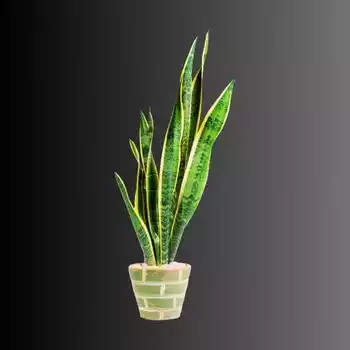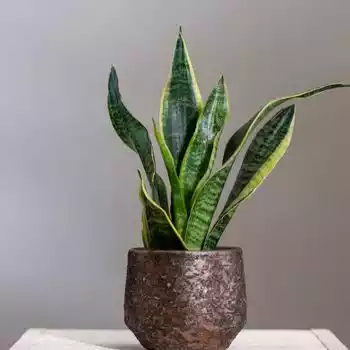The snake plant is one of the most popular houseplants. It is easy to care. The scientific name of the plant is Dracaena trifasciata. It is originated from parts of Africa and Asia.
Snake plants come in various colors and styles. They are low-maintenance plants that purify indoor air. Their hardy nature makes them perfect for beginner plants to keep as houseplants.

This guide will cover the different types of snake plants, care tips, propagation methods, benefits, repotting advice, pet safety, and more. By the end, you’ll be a snake plant pro!
In This Article
Specification of Snake Plant
Here is some important information about this plant.
| General Name | Snake plant, mother-in-law plant, mother-in-law’s tongue |
| Scientific Name | Dracaena trifasciata |
| Plant Family | Asparagaceae |
| Type of Plant | Evergreen perennial is typically grown as a houseplant |
| Mature Size | 2 feet tall when grown as a houseplant and 6 inches to 12 feet tall in native habitat |
| Flower color | White |
| Sun Exposure | Partial, shade |
| Type of Soil | Sandy, well-drained |
| Soil pH Value | Slightly acidic to slightly alkaline |
| Native Area | West Africa |
| Hardiness Zones | 9–11 (USDA) |
| Toxicity | Toxic to both cats and dogs |
| Bloom Time | Spring |
Types of Snake Plant
Over 70 varieties of snake plants can vary in leaf shape, size, color, and pattern. Here are some of the most common:
‘Laurentii’– Tall tapered leaves that are dark green with a yellowish stripe down the center.
‘Cylindrica‘– Thin cylindrical leaves with a classic grass-like appearance.
‘Black Coral’– Dark maroon-black leaves with coral-like texture.
‘Moonshine’– Thick white leaves with curves and the silhouette of a cobra’s hood.
‘Tricolor’– Speckled leaves splashed in cream, gray and green tones.
‘Hahnii’– Tall, narrow, pale green leaves with red edges.
Choosing the snake plant variety is based on personal preference and the look you want to achieve. Snake plants are very adaptable. So, any type of snake plant will thrive indoors.
Snake Plant Care Indoors
Snake plants are famously low maintenance but still require some primary care:

Water
Pour water when the top 1-2 inches of soil are dry. Providing the water once every 2-4 weeks is typical. Snake plants can go longer without water, depending on environmental conditions.
Light
Medium to low light is good for snake plants. They grow best in bright and indirect sunlight from east or west-facing windows. Avoid direct afternoon sun, which can scorch leaves.
Soil
Soils should have a well-draining potting mix. The soil should be suitable for succulents and cacti. However, container planting allows better drainage than soil.
Fertilizer
Fertilize in spring and summer. Apply a diluted liquid succulent fertilizer monthly at 1⁄4 to 1⁄2 for perfect strength.
Temperature
The temperature between 60-80°F is ideal. They can tolerate temperatures down to 50°F.
Humidity
Low to moderate humidity levels between 30-50% suits snake plants.
Proper care means snake plants are impossible to kill! Their resilient nature has made them popular as low-stress houseplants.
Read More Plantation:
How to Propagate Snake Plants
Snake plants spread slowly in nature through underground rhizomes and bulbils. It propagates good at home. It provides a good way to multiply your collection.

Here are a few propagation methods:
Division
Gently pull or cut the plantlet clumps from the mother plant roots. Allow cut ends to heal and root in water or soil.
Leaf cuttings
Cut off a healthy snake plant leaf. Then remove the lower 1/3 and place the cut end in water. Roots will form from the cut end after a few weeks.
Bulbil puppies
Look for small bulbils that form along leaf edges and seams. Detach and replant in soil to grow new plants.
Place the cuttings in a warm spot with indirect light and moisten the soil as new growth develops. You’ll have multiple snake plants from a single starter in a few months!
Snake Plant Benefits
Snake plants provide some health-boosting advantages, besides from being a low-maintenance houseplant. The benefits are discussed below:

Air Purification
Studies show that snake plant helps the environment. They can purify the air. They can remove benzene, formaldehyde, and trichloroethylene from indoor environments.
These are common volatile organic compounds emitted from building materials, cleaning products, and other household items.
Increased oxygen level
Snake plants maintain a steady supply of oxygen in the air in your home, especially at night. snake plants can help to improve sleep quality and reduce fatigue.
Low-Maintenance Care
Snake plants are incredibly easy to care. So it is an excellent choice for busy individuals or those who are new to houseplants.
They can tolerate low light conditions and infrequent watering. Not only that but they are relatively resistant to pests and diseases.
Easy on allergies
Their natural filtering abilities keep pollutants and allergens out of the air. Snake plants create a healthier atmosphere for allergy and asthma sufferers.
Reduce stress and anxiety
Simply gazing at snake plants has been shown to reduce cortisol levels. It also promotes relaxation like other green-growing plants. Their structural foliage creates soothing patterns.
Their low-maintenance nature and attractive appearance can contribute to a more relaxed and stress-free environment.
Feng Shui
In Eastern cultures, snake plants represent protection, longevity, and prosperity. So, place them in your home or office to absorb negative energy and invite positivity.
From controlling toxins to providing calm vibes, snake plants actively work to purify living spaces. They provide benefits in many subtle ways. Their natural gifts help create healthier, happier indoor environments.
How to Repot a Snake Plant
Generally, snake plants will outgrow their original containers. So, they need to be transplanted to roomier pots. Good drainage is vital for their care
So, choose well-draining soil and containers with drainage holes. Here are the simple steps:
- Gently remove the snake plant from its current pot. Try not to disturb the root ball.
- Then check roots for any signs of rotting. Trim away anything mushy with sterilized pruners.
- After that select a nursery pot or decorative cachepot 2-4 inches larger in diameter than the current root ball.
- Then add an inch of pebbles or gravel to the bottom for internal drainage if cachepots don’t have holes.
- Gradually fill with a potting mix for succulents and cacti.
- After that carefully replant the root ball and fill in the sides with more soil, firming lightly.
- Pour water after repotting and moving to its new spot. But keep light and care requirements in mind.
- Finally, with infrequent repotting every 1-2 years as needed, snake plants remain stress-free houseplants. Their hardy nature handles disturbances well.
Is Snake Plant Toxic to Cats?
Many houseplants are dangerous if ingested by cats and dogs. Thankfully, non-toxic snake plants are generally safe for pets. However, there are a few precautions owners should take:
The snake plans are not toxic. But the tough snake plant leaves could pose a choking or intestinal blockage hazard for curious cats if eaten. The same applies to any houseplant ingestion.

So, keep snake plants up high or secured behind barriers where pets can’t reach them. Monitor pets closely around all potted decorations until you’re sure they won’t nibble.
Signs of a snake plant upsetting a pet’s stomach might include vomiting, diarrhea, loss of appetite, or lethargy.
In this situation, you need to contact your vet right away if any concerning symptoms arise. But snake plants coexist peacefully with most pets with supervision and placement in cat-proof areas.
Conclusion
Snake plants live up to their reputation as one of the hardiest, most forgiving indoor plants.
Their unique architectural foliage fits any style, from casual to formal decor. The benefits of air quality, stress relief, and feng shui make them excellent companions.
FAQ:
Q: What is a snake plant?
Snake plant is a type of hardy indoor plant. It is known for its long, upright leaves with various patterns. It is also called Sansevieria.
Q: How often do you water a snake plant?
Provide water to snake plants every 2-6 weeks. But allow the soil to dry between watering.
Q: Why is my snake plant drooping?
Drooping of snake plants might be sue to overwatering or inadequate light.
Q: Why is my snake plant turning yellow?
Yellowing snake plant leaves can result from excessive watering or insufficient light.
Q: How much light does a snake plant need?
Snake plants thrive in moderate to bright indirect light. But it can tolerate low-light conditions.
Q: Why is my snake plant dying?
Snake plants may decline due to overwatering, insufficient light, or root rot. So, assess watering and light levels for revival.
Read More Easy Plantation Method:





